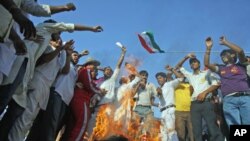The death of a spiritual leader in India after months of fasting against environmental abuses is proof that not all hunger strikes blossom into mass movements. Many Indians are comparing the obscure circumstances of Swami Nigamanand's death to the far more attention-grabbing fast of a celebrity yoga guru, who is very much alive and in the spotlight.
Indian spiritual leader Swami Nigamanand died this week at the age of 36, after more than two months of public fasting against pollution of India's revered Ganga river, also known as the Ganges.
Most Indian broadcasters broke the story Tuesday in short, 30-second reports and the occasional obituary of two or three minutes. There has been nothing close, though, to the hours of rolling live coverage devoted to the recent fast of yoga guru Baba Ramdev.
Ramdev, who presides over a multi-million-dollar yoga and media empire, arrived earlier this month in New Delhi on a chartered jet, where he was greeted by four ruling party Cabinet ministers. He began a fast 10 days ago to support a groundswell movement demanding concrete action against corruption, including the passage of a bill establishing a new organization to police all levels of government graft.
Even after being evicted from the capital, top government officials kept open lines of communication to Ramdev in hopes of ending his hunger strike.
Nigamanand received no such attention, and as he died, he was actually lying in the same hospital intensive care unit in India's Uttarakhand state where reporters swarmed to cover Ramdev's nursing back to health after nine days of fasting.
Delhi University Sociology Professor Mala Kapur Shankardass said Ramdev's fast became a media frenzy and Nigamanand died in relative obscurity because of the level of urgency corruption has taken on for most Indians.
"Anything which has an impact on politics or on socio-economic aspects gets much better coverage," said Shankardass. "Corruption is now a public agenda. Environment is not yet a public agenda."
Deeply rooted corruption has been seen for years as a problem in India. But the past year of headlines alleging billions of dollars in top-level government graft has helped galvanize a populist movement behind Ramdev, as well as social activist Anna Hazare.
Shankardass said environmental protests like Nigamanand's tend to be limited only to the directly affected regions, while issue of corruption can spread to the entire nation.
"And not only is it cutting across all parts of the country, but it also cuts across on ages, and it cuts across gender - male, female, adults, children, old, from any part of the country - are impacted by corruption, and feel strongly about it," he said.
Ramdev and Hazare both have paused their hunger strikes, but warn they will continue their respective campaigns if the government does not take strong anti-corruption measures. Ramdev was quoted as offering a tribute to Nigamanand, calling him a saint who laid down his life for the Ganga.
Indian Swami's Death Draws Scant Attention
- By Kurt Achin






